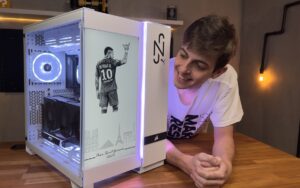
Artificial Intelligence (AI) has been a hot topic in several areas of technology, and as a result, the focus on its tools has been growing over the months. This generates rapid evolution, with increasingly advanced intelligent solutions, especially in the generative segment.
In this way, what once seemed like science fiction has now become reality, and a living example of this are the hyper-realistic videos that are circulating on social media, leaving many wondering how far this technology can go. Recently, a video made by AI has caught the internet’s attention. Find out more!
The AI-generated video that baffled the internet
OpenAI recently introduced Sora, a powerful tool capable of generating hyper-realistic video clips using AI. Soon, other technologies such as Kling and Dream Machine followed suit, demonstrating the potential of AI in creating high-quality visual content.
These tools not only impress with the quality of the videos produced, but also raise some important questions about the ethical limits and possible implications of using this technology.
A recent example that illustrates the impact of these new tools is a video of a woman giving an interview. In the video, she holds a microphone and wears a Google ID badge, while speaking naturally and making gestures that do not arouse suspicion.
Let’s bring in some motion, shall we? pic.twitter.com/17UlboTFLI
— Nicolas Neubert (@iamneubert) August 9, 2024
What surprised everyone is that this woman is not real, she was created entirely by AI. This video, which has fooled thousands of people on social media, highlights how AI is becoming increasingly convincing in creating digital humans.
The video was created using a combination of technologies, including the Flux image generation model and the Lora+ Gen-3 Alpha video generation tool. These systems transform a simple image into a realistic video fragment, demonstrating the power of AI in creating visual content that can easily fool the average viewer.
Social media backlash and concerns about what is real
The reaction to the video was immediate and polarizing. Nicolas Neubert, the creative director responsible for publishing the video, aims to “redefine cinematic storytelling through AI.” And he succeeded: the video, just 10 seconds long, quickly went viral, sparking debate about the reliability of what we see online.
Many users expressed concern, saying that “we can no longer believe anything we see.” Others dedicated themselves to finding the small flaws in the video that revealed its artificial origin, such as mouth movements, facial gestures, and eye and arm movements.
In addition to being surprising, this new generation of AI-generated videos also raises alarming questions about authenticity in the digital age. One user on X (formerly Twitter) summed up the concern well: “We are on the verge of deepfakes being so realistic that it will be very difficult to differentiate them from reality.”
This comment highlights the fear that AI-generated videos could be used for malicious purposes, such as falsely incriminating someone, manipulating public opinion through political propaganda, or even creating fictitious relationships with AI-generated partners.
AI’s progress in creating realistic videos has been rapid. In just over a year, the technology has advanced in unimaginable ways, with examples ranging from the infamous video of Will Smith eating pasta to videos like the one featuring Google’s fictional wife.
Fonte: genbeta
Source: https://www.hardware.com.br/noticias/ira-bugar-seu-cerebro-esse-video-parece-real-mas-foi-gerado-por-ia.html


